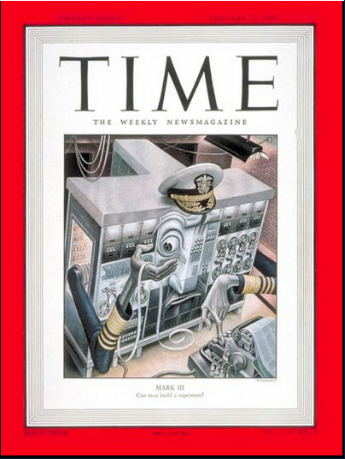About | Use | Crew | Function | Manual | Language | Futurism | Video
Futurism
 Mark I’s streamlined outer case was the work of Norman Bel Geddes, one of the 20th century’s most influential designers, who worked for IBM during the 1940s. This futuristic look (characteristic of the Art Moderne or Streamline Moderne movement in American industrial design) put Mark I in stark contrast to all other computers of the first generation, which were disparate assemblages of electrical, mechanical, and electronic components. Using illumination, Bel Geddes highlighted the machine’s innovative working units and downplayed the stock IBM parts.
Mark I’s streamlined outer case was the work of Norman Bel Geddes, one of the 20th century’s most influential designers, who worked for IBM during the 1940s. This futuristic look (characteristic of the Art Moderne or Streamline Moderne movement in American industrial design) put Mark I in stark contrast to all other computers of the first generation, which were disparate assemblages of electrical, mechanical, and electronic components. Using illumination, Bel Geddes highlighted the machine’s innovative working units and downplayed the stock IBM parts.
 Mark I and its successors at Harvard were featured in the 1950 cover story of Time Magazine foreseeing artificial intelligence.
Mark I and its successors at Harvard were featured in the 1950 cover story of Time Magazine foreseeing artificial intelligence.
"On Oxford Steet in Cambridge, Mass. lives a sibyl, a priestess of science. Her devotees take their problems to her as devout ancient Greeks took their insolubles to Delphi. She is no mumbling, anonymous priestess, frothing her mouth with riddles. Her name is Bessie; she is a long, slim, glass-sided machine with 760.000 parts, and the riddles that are put to her and that she unfailingly answers concern such matters as rocket motors, nuclear physics and trigonometric functions". For a computing machine, Bessie is old: she has been steadily at work since 1944. And she is not the brightest of her breed. Compared to her children and grandchildren (one of whom, Harvard's Mark III lives on the floor below in Harvard's Computation Laboratory), she is dim-witted and slow. But Bessie is a progenetrix, a sort of mechanical Eve. By proving what computing machines could do, she started one of the liveliest developments of modern science. Some scientists think that Bessie's descendants will have more effect on Makind than atomic energy. Modern man has become accustomed to machines with superhuman muscles, but machines with superhuman brains are still a little frightening. The men who design them try to deny that they are creating their own intellectual competitors."
‒Time Magazine, January 23, 1950, p54.
